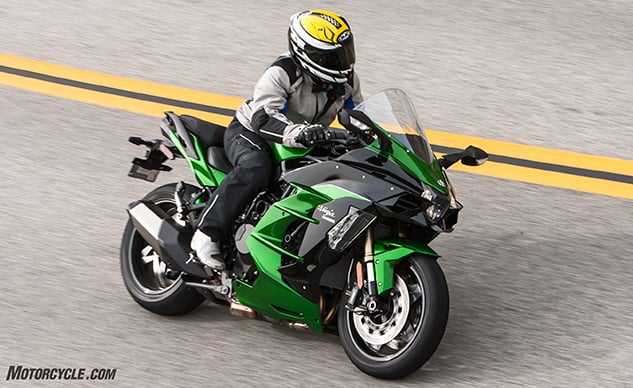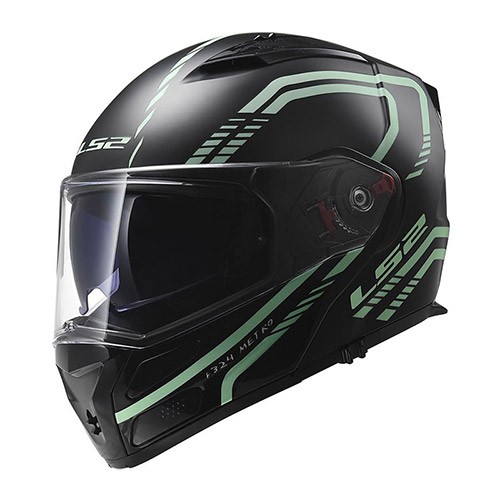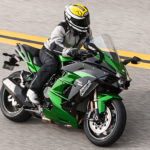
2018 Kawasaki Ninja H2 SX
Editor Score: 97.25%
| Engine | 20/20 |
| Suspension/Handling | 14.5/15 |
| Transmission/Clutch | 9.75/10 |
| Brakes | 9.75/10 |
| Instruments/Controls | 4.75/5 |
| Ergonomics/Comfort | 9.5/10 |
| Appearance/Quality | 9.75/10 |
| Desirability | 9.75/10 |
| Value | 9.5/10 |
| Overall Score | 97.25/100 |
It’s funny how time’s arrow flies. Seems like only yesterday we were in a chill and rainy Milano for the big international motorcycle exposition, drooling over the showstopping new Ninja H2 SX SE with Sean Alexander and Brent J., knocking out non-award-winning videos and wondering what Kawasaki could possibly be thinking to produce such an outrageous motorcycle? Shirley it will be way expensive and unobtainable like the other H2s?
EICMA: 2018 Kawasaki H2 SX SE First Look
2015 Kawasaki Ninja H2 First Ride Review
Lo and behold, here it is four months later and 6000 miles removed, and it’s just me flogging the green beastie up and down my favorite test circuit under clear desert skies – and I only am escaped alone to tell thee… not only is the H2 SX SE only $22,000, the base model’s just $19k. I hate to break the news, but that’s what a premium motorcycle costs now.
Get the Flash Player to see this player.
I’ve forgotten exactly what backroom machinations culminated in MO getting the exclusive North American first-ride scoop on the SX, but it’s best just to say thank you, Sean A. and Kawasaki, and not look this gift horse in the mouth. On this bike, it’s best to keep one’s eyes on the road.
The big deal, of course, is the supercharger, and its main function seems to be to compress time and space along with air. The H2’s engine just never feels like it’s working all that hard beneath you, but past 7 or 8,000 rpm on the tachometer, speed seems to increase at a rising rate, and suddenly your faceshield is filled with corner – it’s the kind of speed that makes you grab the brakes too early. (Natch, we have great brakes with electronic assist that have no problem reining the beast right back in with road to spare.) Why are we rolling so slow through this perfectly paved corner, asks the Kawasaki? It takes a while to adjust, but after that, it’s very nice to have warp drive an eighth of a throttle twist away.

A planetary gear train running off the crankshaft gets this intricately machined 69mm impeller puppy whirring along at 9.2 x crank speed – reaching maximum speeds of nearly 130,000 rpm. Six blades at the tip expand to 12 at the base. If you want one for your mantel, Bike Bandit will sell you the entire Compressor Assembly part #15060-0005, for $3,292.95 (2017 H2).
Yes, there are more powerful 1000cc sportbikes than this 171-horsepower one, including the 180-hp Aprilia RSV4RR and 177-hp BMW S1000RR that duked it out in last year’s Superbike Shootout. But they make their power well past 13,000 rpm; you have to work for it a little. The H2’s artificial air inseminator lets its 998cc four-cylinder produce its peak at just 10,300 rpm. And even more to the point is the fact that the H2’s blown motor is making more torque way sooner – 89 pound-feet of the stuff at just 8600 rpm. The S1000RR puts out 80 lb-ft at 9600 rpm, the Aprilia 78 at 11,300.

The street specific Ninja H2 SX supercharger design and tuning were developed by Kawasaki Heavy Industries, Ltd. to showcase its in-house knowledge of forced induction. High efficiency and minimal heat gain, aided by the use of this aluminum airbox and good airflow through the trellis frame, eliminate the need for an intercooler and let the impeller be placed in the best position to distribute compressed air to all four cylinders. An ECU-controlled blow-off valve releases pressure in the intake chamber when the throttle is closed to prevent impeller surging and abnormal vibration. A sound hole in the intake duct lets you hear the impeller chirping as it breaks the sound barrier when you roll off the gas at speed. Or something like that. I prefer to think of it as angel wings fluttering around my helmet.
Well, the SX is also 100 or more pounds heftier than those true sportbikes, but in its natural habitat – fast, open roads – you’d be hard pressed to tell. That extra weight takes the form of a cockpit with room for two and a beefed-up subframe capable of carrying a 430-pound payload and saddlebags – not to mention a standard centerstand and one-sided swingarm that’ll make changing rear tires a snap (a thing you might be doing a lot). More importantly, the SX, at 576 pounds wet on the MO scales, is around 100 pounds lighter than the next step up the hard-luggage-equipped Kawasaki food chain – the 1352cc Concours 14.

Is the H2 SX a sport tourer or a sportbike? It’s having a hard time deciding. To me, it’s way more tourable than slightly more-powerful but heavier megabikes like the ZX-14R and Hayabusa. At the same time, comparing the SX to our reigning sport-touring champ BMW R1200RT would seem like an apples and oranges affair – not that we’re always opposed to those. Really, the H2’s very cool supercharger tech means the bike is carving out its own niche somewhere between sport and sport-touring. Counterintuitively, Kawasaki uses the word “efficiency” quite a bit in describing it. You can definitely get through the H2’s five-gallon fuel tank quickly when you’re blasting up and down Montezuma Grade. But when I rode the 120 miles home after two days of that, at a slightly more sedate pace, we got 42 miles per gallon. That’s way better than Aprilia V4s, BMW S1000RRs and ZX-14Rs and Hayabusas.

Sedate being a relative term here. All motorcycles seem to have a happy speed (or maybe it’s just the rider?), but the H2 seems most content when it’s rolling along with the tachometer needle at 6000 rpm. The digital speedo says that’s about 90 mph in top gear, which nobody on California backroads and freeways seems to object to much lately. Knock on wood.

Even the jaded and crusty Mickey, of Mickey Cohen Motorsports, was impressed by this extremely smooth, linear power curve. A thing of beauty. It also appears the curve could continue upward quite a bit after 10,000 rpm with a little fine tuning.
From cruising speed, should the mood strike you and you find yourself alone on the road and bored, whacking the H2 SX’s throttle open seems to have the speedo into triple digits sooner than most monster bikes. Its supercharger is the same unit used in the original H2 and H2R, but its impeller blades are angled differently to produce less boost up high, more in the midrange (along with lots of other engine changes). The SX is the streetable H2, designed for real-world use instead of hyper performance and top speed: 6500 rpm seems to be where the blower starts really blowing. From 6500 to 8000 rpm we go from 95 to 130 hp, and from 77 to 86 lb-ft of torque. And from there the acceleration verges on intense even in sixth gear. It feels like the ram air duct that feeds the supercharger is really effective – a thing a stationary dyno can’t measure.

The 197.3 crankshaft hp Kawasaki claims jumps to 206.7 hp with ram air effect. The oil pan is even cool: “More efficient combustion produces less heat so that the pistons can be cooled by a single oil jet, which allows the oil pump to turn at a slower rate to reduce friction loss. This also allowed the engine’s oil volume to be reduced by nearly a half quart which contributes to weight savings. Large, deep-sump oil pan helps cool oil. Oil pan design ensures the oil pump is always surrounded by oil to prevent cavitation.”

Achieving the desired fuel efficiency while maintaining the low- to mid-rpm performance characteristics of the H2 platform meant improving the engine’s thermal efficiency by increasing the compression ratio from 8.5:1 to 11.2:1; this was done with new cast aluminum pistons with a revised crown, new cylinder head and cylinder. Squish is now 1mm instead of 4mm, and the new pistons are said to improve combustion and help prevent engine knock. Intake and exhaust cam profiles were shortened to match the reduced airflow requirements of street riding. Exhaust header pipes are 2.2mm smaller in diameter with connector pipes between cylinders which contribute to low-mid range torque and higher fuel efficiency – and a new muffler with less volume is 6.6 pounds lighter than the original H2 unit.
Those engine changes mean the SX runs cooler than the original H2s, so the bike’s now fully enclosed in plastic and there’s a bigger, more sheltered cockpit for the now more-upright rider, who gets to grab grips high above the top clamp instead of clip-ons mounted below it. Ergonomics, again, are neither as upright as a BMW R1200RT nor as sporty as an S1000RR – but somewhere in the middle. After two long days in the saddle, my rear end was only beginning to complain a bit from the slightly crowned saddle; the rest of me – back, shoulders and wrists felt fine. Judging from the photos, I’m going to guess that raised passenger seat will be better suited to an aspiring new friend than to a long-suffering spouse who knows where all your bones are buried – but at least the SX has a passenger seat.

Kawasaki says: The trellis frame is made of high-tensile steel with pipe diameter, thickness and bend of each piece carefully selected to obtain the necessary stiffness. The steering head was moved forward 15mm, contributing to a 30mm longer wheelbase and enabling a wider 30-degree steering angle for easier low-speed maneuverability. The engine was tilted forward two degrees to help lower the center of gravity, which contributes to overall handling and stability. Stronger, longer rear frame increases the payload by nearly 200 pounds. Slim frame design and horizontal mounting of the die-cast aluminum rear subframe helps keep seat narrow for a shorter reach to the ground. Open design of trellis frame allows air to pass through it to help dissipate engine heat. Swingarm mounting plate is bolted to the back of the engine to make it part of the frame – eliminating frame cross members for lightness and increasing stiffness.
Running along anywhere from 70 to 100 is absolute bliss for 5’8” me on this one, the tall bubble leaving my noggin in clean air and negating most of the weight on the wrists. If I hadn’t been told the fully adjustable suspension is from KYB, I would’ve guessed it was Swedish: supple, bump-absorbent, yet firmly in control well into the triple-digit speeds the SX is able to dial up at a few seconds notice. The shock has low- and high-speed compression adjusters I didn’t really feel the need to adjust, though I did put in a couple turns of rear preload to keep the footpeg feelers from touching down.

Over there on the left cluster you’ll find the controls for Kawasaki’s first cruise control on a sportbike, just inboard from the rocker switch that adjusts all its other electronic aids. (No backlighting, though, so good luck adjusting after dark.) The three-setting heated grips (standard on this SE) have their own dedicated button exactly where it should be, and there’s a 12v outlet right up there under the speedo, too. No infotainment, though. Sorry. Dual secondary balancers make this one smoooth four cylinder. Vibration through grips and other contact points is negligible. What’s the transcontinental record at these days?
I’m starting to think there’s something to these steel trellis frames. Like the KTM Super Duke GT and Yamaha MT-07, the H2 SX has a certain supple organic feel that keeps you in intimate contact with the contact patches – in this case, very nice Bridgestone S21 rubber – when you start swerving through the curves: 4.1 inches of trail via 24.7 degrees rake is steeep enough, and a 58.3-inch wheelbase is short enough to keep the SX pretty light on its feet, and its modern electronics package, complete with Bosch 6-axis IMU, encourages you to channel your inner Jonathan Rea.

This is Sport Mode on the TFT, and you can substitute the lean angle gauge up there where Trip B is currently. Bosch’s compact IMU allows an additional layer of precision to be added to Kawi’s electronics. The system uses minimal hardware but complex Kawasaki proprietary software to monitor IMU inertia along six DOF (degrees of freedom). “Acceleration along longitudinal, transverse and vertical axes, plus roll rate and pitch rate are measured. The sixth axis, yaw rate, is calculated by the ECU using Kawasaki’s proprietary software developed through World Superbike racing. Additional feedback from the IMU gives an even clearer real-time picture of chassis orientation, as it combines chassis orientation information with real time monitoring of the rider’s movements.”
Again, the 43mm inverted fork and linkage-mounted shock on the SX represent some of the best suspension tuning Kawasaki’s ever done on a street bike if not the best. Mixed in with strong triple disc brakes equipped with Kawasaki’s lean-sensitive Intelligent Braking System and KTRIC three-level traction control (which is easy to turn off if you insist), the SX feels like it would be a match for any motorcycle on the fast, flowing roads it prefers. All its systems work seamlessly together to let you pay attention to the road from the minute you hit the starter button.

For some reason, the SX’s burly exhaust note seems relatively quiet, its slip/assist slipper clutch gives the lever a nice, light pull – and the quickshifter on the SE means you really don’t need to touch it again once rolling (though I instinctively use a little clutch on the 1-2 upshift). The dog-ring style six-speed gearbox never misses a shift. First and second are taller than on the H2, and this is the first Kawasaki I’ve ridden that will allow you to shift into second from neutral if you want to. In first or second, if you’re brave enough to hold the throttle wide open, the front wheel will begin coming up; luckily the SE has Launch Control Mode to keep it from coming up too far.

I regret that I was in the bar when I should’ve been out testing these cornering lights, exclusive to the SE, but it had been a long day. Three lights at 10, 20 and 30 degrees are activated by the lean angle of the motorcycle, creating a wider path of light.
Some years ago, Kawasakis had a rep for being a bit crude, a little rough around the edges. This one is anything but unless you just object to green metalflake. They don’t put that rivermark logo on just any motorcycle; this one’s built to show just how nice a motorcycle Kawasaki can build. An extremely nice one, as it turns out, in addition to one that’ll blow (almost literally) the doors off 99.99% of everything else on the road. I’m pretty sure 97.5 is the highest I’ve ever ranked any bike on the MO scorecard, and the only time I’ve ever given an engine a perfect 20. I think the bar just got raised.
Stuff the SE has:
- KQS Kawasaki Quick Shifter
- KLCM Kawasaki Launch Control Mode
- Larger windscreen
- LED cornering lights
- Comfort seat
- Heated grips
- Steel braided brake lines
- Centerstand
| 2018 Kawasaki Ninja H2 SX SE | |
+ Highs
|
– Sighs
|
| 2018 Kawasaki Ninja H2 SX SE Specifications | |
|---|---|
| Engine Type | 4-stroke, 4-cylinder, DOHC, 4-valve, liquid-cooled, supercharged |
| Displacement | 998cc |
| Bore x Stroke | 76.0 x 55.0mm |
| Compression ratio | 11.2:1 |
| Horsepowe | 171.7 at 10300 rpm as measured on Dynojet 250i |
| Torque | 89.1 at 8600 rpm as measured on Dynojet 250i |
| Fuel System | DFI with 40mm throttle bodies (4) with dual injection |
| Ignition | TCBI with digital advance |
| Transmission | 6-speed, return, dog-ring |
| Final Drive | Sealed chain |
| Electronic Rider Aids | Kawasaki Corner Management Function (KCMF), Kawasaki Traction Control (KTRC), Kawasaki Launch Control Mode (KLCM), Kawasaki Intelligent anti-lock Brake System (KIBS), Kawasaki Engine Brake Control, Kawasaki Quick Shifter (KQS) (upshift & downshift), Öhlins Electronic Steering Damper, Cruise Control, LED Corning Lights |
| Front Suspension | 43mm inverted fork with rebound and compression damping, spring preload adjustability and top-out springs, 4.7 in. travel |
| Rear Suspension | New Uni-Trak, gas charged shock with piggyback reservoir, compression and rebound damping and spring preload adjustability, and top-out spring, 5.5 in. travel |
| Front Brakes | Dual radial-mount, opposed 4-piston monoblock calipers, dual semi-floating 320mm discs, KIBS ABS |
| Rear Brakes | Opposed 2-piston calipers, single 250mm disc, KIBS ABS |
| Front Tire | 120/70 ZR17 (58W) |
| Rear Tire | 190/55 ZR17 (75W) |
| Frame Type | Trellis, high-tensile steel, with swingarm mounting plate |
| Rake/Trail | 24.7/4.1 in |
| Wheelbase | 58.3 in |
| Overall Length | 84.1 in |
| Overall Width | 30.5 in |
| Overall Height | 49.6 in |
| Ground Clearance | 5.1 in |
| Seat Height | 32.9 in |
| Wet Weight | 576 lb as measured |
| Fuel Capacity | 5.0 gal |
| Fuel Mileage | 40 mpg as observed |
| Color Choices | Emerald Blazed Green/Metallic Diablo Black |
| Warranty | 12 Month Limited Warranty Kawasaki Protection Plus (optional): 12, 24, 36 or 48 months |

